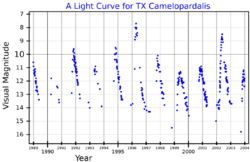Astronomy:TX Camelopardalis
From HandWiki
Short description: Star in the constellation Camelopardalis
| Observation data Equinox J2000.0]] (ICRS) | |
|---|---|
| Constellation | Camelopardalis |
| Right ascension | 05h 00m 50.39s |
| Declination | +56° 10′ 52″ |
| Apparent magnitude (V) | 7.8 - 16.9[2] |
| Characteristics | |
| Spectral type | M8/10III[3] |
| Variable type | Mira[2] |
| Astrometry | |
| Proper motion (μ) | RA: 11.448[4] mas/yr Dec.: −21.294[4] mas/yr |
| Parallax (π) | 2.9991 ± 0.3335[4] mas |
| Distance | approx. 1,100 ly (approx. 330 pc) |
| Details | |
| Radius | 460,[5] 305-727[3] R☉ |
| Luminosity | 9,638[6]-11,360[5] L☉ |
| Temperature | 2,300[7]-2,779[5] K |
| Other designations | |
| Database references | |
| SIMBAD | data |
TX Camelopardalis (abbreviated TX Cam) is a Mira-type variable star in the constellation Camelopardalis. It is a classical long period variable star with pulsational period of 558.7 days.[2] Water masers have been observed around the star.[8]
References
- ↑ "Download Data". AAVSO. https://www.aavso.org/data-download.
- ↑ 2.0 2.1 2.2 Samus, N. N. et al. (2009). "VizieR Online Data Catalog: General Catalogue of Variable Stars (Samus+ 2007-2013)". VizieR On-line Data Catalog: B/GCVS. Originally Published in: 2009yCat....102025S 1: B/gcvs. Bibcode: 2009yCat....102025S.
- ↑ 3.0 3.1 Kemball, A. J.; Diamond, P. J. (1997). "Imaging the Magnetic Field in the Atmosphere of TX Camelopardalis". Astrophysical Journal Letters 481 (2): 111–114. doi:10.1086/310664. Bibcode: 1997ApJ...481L.111K.
- ↑ 4.0 4.1 4.2 Brown, A. G. A. (August 2018). "Gaia Data Release 2: Summary of the contents and survey properties". Astronomy & Astrophysics 616: A1. doi:10.1051/0004-6361/201833051. Bibcode: 2018A&A...616A...1G. Gaia DR2 record for this source at VizieR.
- ↑ 5.0 5.1 5.2 De Beck, E.; Decin, L.; De Koter, A.; Justtanont, K.; Verhoelst, T.; Kemper, F.; Menten, K. M. (2010). "Probing the mass-loss history of AGB and red supergiant stars from CO rotational line profiles. II. CO line survey of evolved stars: derivation of mass-loss rate formulae". Astronomy and Astrophysics 523: A18. doi:10.1051/0004-6361/200913771. A18. Bibcode: 2010A&A...523A..18D.
- ↑ Olivier, Enrico A.; Whitelock, Patricia; Marang, Fred (2001). "Dust-enshrouded asymptotic giant branch stars in the solar neighbourhood". Monthly Notices of the Royal Astronomical Society 326 (2): 490. doi:10.1046/j.1365-8711.2001.04511.x. Bibcode: 2001MNRAS.326..490O.
- ↑ Lorenz-Martins, S.; Pompeia, L. (2000). "Modelling of oxygen-rich envelopes using corundum and silicate grains". Monthly Notices of the Royal Astronomical Society 315 (4): 856. doi:10.1046/j.1365-8711.2000.03486.x. Bibcode: 2000MNRAS.315..856L.
- ↑ Kemball; Diamond, Philip J.; Gonidakis, Ioannis; Mitra, Modhurita; Yim, Kijeong; Pan, Kuo-Chuan; Chiang, Hsin-Fang (2009). "Multi-epoch imaging polarimetry of the SiO masers in the extended atmosphere of the Mira variable TX Cam". The Astrophysical Journal 698 (2): 1721–1739. doi:10.1088/0004-637X/698/2/1721. Bibcode: 2009ApJ...698.1721K.
 |


